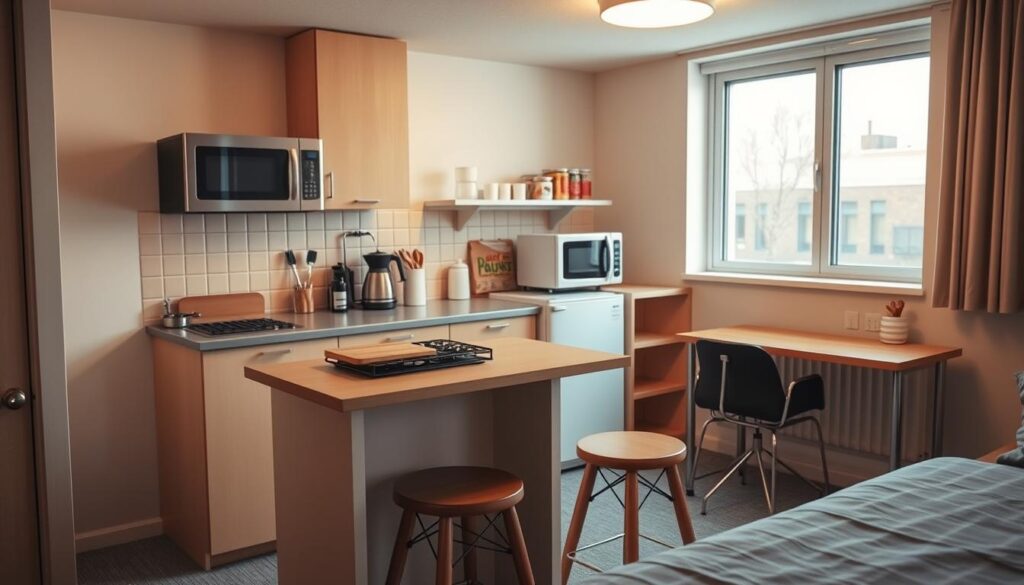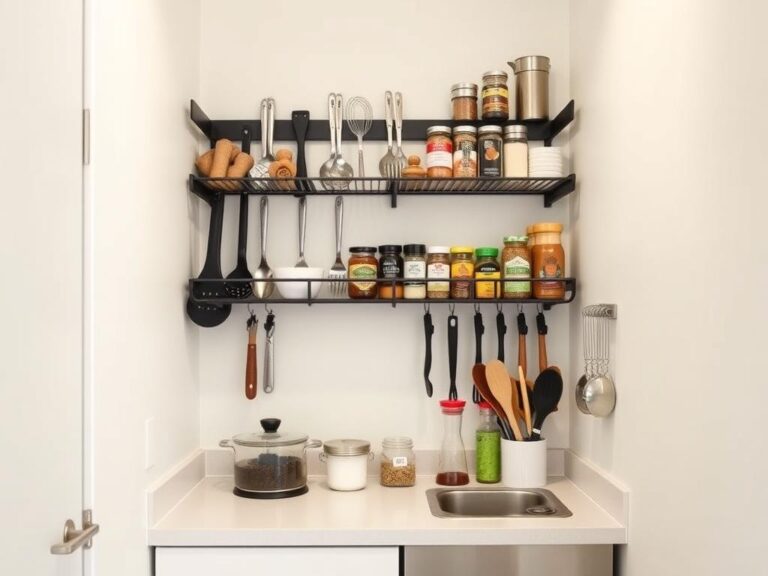Dorm Kitchen Essentials: What You Really Need (and What to Skip)
Discover the must-haves for your dorm kitchen. Learn the dorm kitchen essentials you need and what you can skip to make the most of your space.
Moving into shared campus housing brings exciting freedom—and a few challenges. Limited counter space, tight budgets, and shared appliances mean every item in your cooking area must earn its keep. While flashy “starter kits” promise convenience, they often include gadgets you’ll never use or flimsy tools that break by midterms.

Smart shopping starts with focusing on versatility. A single pot that works on hot plates and in microwaves beats specialized tools. Look for materials like stainless steel or tempered glass that survive daily use. Dishwasher-safe designs save time, while stackable containers maximize cramped storage.
Budget-conscious students should prioritize items that handle multiple tasks. A quality chef’s knife outperforms a dozen cheap utensils. Microwave-safe meal prep containers double as mixing bowls. Skip single-use gadgets like avocado slicers—your limited square footage is better used for basics.
Key Takeaways
- Focus on multi-purpose tools that work with hot plates, microwaves, and shared ovens
- Choose durable, easy-clean materials over trendy but fragile options
- Prioritize space-saving designs like collapsible strainers or nesting bowls
- Avoid single-task gadgets that clutter small workspaces
- Invest in 2-3 quality pieces rather than bulk sets with filler items
- Look for microwave-safe and freezer-friendly containers for meal prep
Introduction to Dorm Kitchen Essentials
A functional cooking space transforms college living from survival to thriving. While meal plans offer convenience, having control over your food choices supports both physical health and academic performance. Research shows students who cook regularly save $1,200+ annually compared to daily takeout buyers—funds better spent on textbooks or weekend adventures.
Why Your Cooking Setup Impacts Campus Life
Preparing meals fosters independence while creating comforting routines. A junior at UCLA shares: “My mini blender and microwave rice cooker got me through finals week—homemade smoothies and stir-fries kept me energized without leaving the library.” This balance between nutrition and convenience becomes crucial during hectic exam periods.
Working With What You Have
Most campus housing kitchens face three core challenges: counter space smaller than a twin mattress, appliance restrictions, and communal storage. Fire codes often ban hot plates or air fryers, while shared microwaves might be floors away. Solutions exist—collapsible silicone colanders fit in pencil cases, and magnetic spice racks utilize vertical space.
What Else Would You Like to Know?
Choose below:
Always check your housing handbook before buying appliances. As one RA notes:
“We confiscate more coffee makers than textbooks during room checks—students forget Keurigs require special permits here.”
Prioritize versatile tools that adapt to these realities rather than fighting them.
Curating the Perfect College Kitchen Setup
Creating an efficient cooking area starts with understanding your unique living situation. Campus housing varies wildly—some spaces offer full appliances, while others limit you to a mini-fridge and communal microwave. Your setup should match both your culinary ambitions and real-world constraints.
Assessing Your Space and Needs
Start with a tape measure. Document every inch of counter space, cabinet depth, and fridge shelf capacity. A University of Michigan study found students waste 23% more money on unnecessary items when they skip this step.
Ask yourself three questions: How often will you cook? Who else might eat these meals? What appliances are already available? Most campus housing provides microwaves, but check rules about rice cookers or blenders.
| Feature | Shared Spaces | Private Areas |
|---|---|---|
| Storage Needs | Collapsible, lockable | Permanent organizers |
| Appliance Access | Communal microwaves | Personal hot plates |
| Portability | Essential | Optional |
Adapting to Shared and Solo Kitchens
In communal areas, think like a nomad. Magnetic spice jars stick to file cabinets, while silicone bowls nest inside backpacks. One NYU junior shares: “I keep my entire setup in a shower caddy—it goes from dorm room to shared kitchen in 30 seconds.”
Private cooking spaces allow more flexibility. Use vertical racks for pans and stackable containers for dry goods. Always consider semester moves—40% of students damage items during year-end packing.
Budget-Friendly Dorm Kitchen Essentials
Building a practical cooking setup doesn’t require emptying your savings. With 73% of students reporting limited grocery budgets, smart spending means knowing where to invest and where to save. Price tiers for college-friendly tools break down into four categories:

| Price Tier | Best For | Example Items |
|---|---|---|
| $ ($0-$20) | Thrift store finds | Measuring cups, mixing bowls |
| $$ ($21-$40) | Core tools | Chef’s knife, silicone spatulas |
| $$$ ($41-$65) | Multi-use appliances | Blender with food prep attachments |
| $$$$ ($65+) | Long-term investments | Durable cookware sets |
Smart Spending Without Sacrificing Quality
A $15 chef’s knife used daily costs just pennies per meal compared to replacing $5 knives each semester. Focus on three core pieces: one sharp blade, a heat-resistant spatula, and a microwave-safe container that doubles as a mixing bowl. As a Boston University senior advises: “I’ve had the same glass storage set since freshman year—it works for leftovers, meal prep, and even baking.”
Affordable Sets and Starter Kits
While 12-piece bundles seem tempting, most students only use 4-5 items regularly. Look for compact sets with these essentials:
- Collapsible colander (saves space)
- Adjustable measuring spoons
- Multi-size food containers
Retailers like Target and Bed Bath & Beyond offer student discounts during August and January—perfect timing for upgrading key pieces without overspending.
Must-Have Cooking Appliances for Dorm Rooms
Compact appliances become the backbone of fast, nutritious meals in campus housing. Choosing devices that align with electrical rules and space limitations requires strategic thinking. Focus on units that handle multiple cooking methods while fitting in tight quarters.
Microwave and Toaster Options for Quick Meals
A quality microwave does more than warm pizza. Steam vegetables in microwave-safe containers or cook scrambled eggs in silicone molds. Look for models with sensor reheating to prevent overcooking.
Toaster ovens outperform basic slots by baking small batches of cookies or roasting veggies. Compact models with convection settings cook 25% faster than standard versions. Pair with heat-resistant silicone mats for easy cleanup.
| Appliance | Best Feature | Space Needed |
|---|---|---|
| 900W Microwave | Pre-programmed settings | 1.2 sq ft |
| 4-Slice Toaster Oven | Air fry function | 1.5 sq ft |
| Electric Kettle | 5 temp settings | 0.8 sq ft |
Mini blenders like the Magic Bullet crush ice for smoothies and chop veggies for salsas. “I make pancake batter in mine every Sunday,” shares a USC sophomore. Breakfast sandwich makers cook eggs and melt cheese simultaneously—perfect for 8 AM classes.
Always check voltage requirements before buying. Some campuses restrict high-wattage devices. Multi-functional appliances reduce clutter while expanding meal options throughout the semester.
Essential Utensils and Tools for College Cooking
The right tools can turn chaotic meal prep into efficient cooking sessions. Focus on professional-grade items that handle daily tasks without cluttering limited storage areas. Three core pieces cover 90% of student cooking needs: a chef knife, paring knife, and serrated blade.
High-Quality Knives and Cutting Boards
The Henckels 3-piece set outperforms budget options with precision-forged blades that stay sharp through hundreds of meals. Students report these knives “slice tomatoes like butter even after two years of use” compared to flimsy sets needing monthly replacement.
Pair blades with grippy cutting boards featuring rubber edges. These prevent slips during chopping and protect countertops from scratches. Store knives in compact drawer organizers rather than bulky blocks—a space-saving trick used by culinary students.
Versatile Gadgets That Do More
OXO’s 6-piece tool kit solves multiple challenges with ergonomic designs. Their tongs flip grilled cheese, serve salads, and retrieve toast from narrow toaster slots. A Boston College senior notes: “The can opener doubles as a bottle opener—perfect for pasta nights and game days.”
Prioritize tools serving 3+ functions. A box grater shreds cheese, zests citrus, and slices veggies. Silicone spatulas scrape bowls clean while resisting melting near hot surfaces. These multi-taskers eliminate single-use gadgets crowding drawers.
Smart Storage and Organization Hacks for Small Kitchens
Transforming cramped cooking areas into functional spaces requires creative thinking. Vertical surfaces and multi-purpose designs unlock hidden potential in even the tiniest setups. Strategic storage solutions reduce clutter while keeping tools within arm’s reach during busy study breaks.
Drawer Organizers and Hanging Racks
The Joseph Joseph DoorStore system revolutionizes cutting board storage. These boards slide into cabinet-mounted cases, freeing drawers for bulkier items. One user notes: “I reclaimed two entire shelves by moving my boards to the door—game changer for shared spaces.”
Nesting tools maximize every inch. Wire strainers that stack inside each other handle pasta draining and veggie rinsing without hogging cabinet space. Stainless steel bowls with rubber bases stay put during mixing, while their lids replace plastic wrap for fridge storage.
Magnetic strips turn appliance sides into tool hubs. Mount lightweight measuring spoons or bottle openers here for quick access. Drawer dividers prevent utensil chaos—assign specific zones for spatulas, whisks, and other frequently used gadgets.
For tight quarters, consider collapsible silicone containers. These squash flat when empty but hold full meals when expanded. One set replaces multiple plastic containers, simplifying both cooking and cleanup routines in crowded environments.
Cleaning and Maintenance Supplies for Dorm Kitchens
Maintaining a clean cooking space in shared campus housing isn’t just about hygiene—it’s a survival skill. Shared surfaces see heavy use, and forgotten crumbs quickly attract unwelcome pests. A well-organized cleaning kit prevents 83% of common conflicts among roommates, according to a recent UCLA housing survey.
Essential Cleaning Tools and Solutions
Start with a caddy holding dish soap, disinfecting spray, and reusable scrubbers. Opt for concentrated formulas to save storage space—one bottle makes 50+ washes. A sponge holder with drainage holes keeps tools dry between uses, reducing bacterial growth by 67% compared to leaving them on counters.
Specialized brushes tackle tough jobs. A long-handled bottle cleaner reaches into water tumblers, while silicone straw brushes prevent mold buildup. “I use my $3 brush set daily for smoothie cups and travel mugs,” notes a University of Texas junior.
- Microfiber cloths replace paper towels (saves $100/year)
- Compact broom/dustpan combos fit behind doors
- Disinfecting wipes kill germs on shared appliance handles
Quality dish towels outperform cheap versions, absorbing spills faster and lasting through 100+ washes. Store them in labeled bins to avoid mix-ups with roommates’ linens. Weekly wipe-downs of microwaves and mini-fridges prevent sticky messes during midterm crunch times.
dorm kitchen essentials: What to Skip and Why
Smart space management begins with knowing what to exclude as much as what to include. Campus cooking areas demand ruthless editing—every square inch matters when you’re sharing appliances and storage with roommates.
Avoid these common pitfalls to maintain functionality without clutter. Many products marketed to students solve nonexistent problems or duplicate existing tools.
Avoiding Unnecessary Gadget Overload
Air fryers top the skip list. These countertop ovens perform tasks a microwave or toaster can handle. A University of Colorado study found 78% of students stopped using theirs within six weeks due to cleaning hassles and space demands.
Massive utensil bundles waste money and storage. One sophomore shares: “My 22-piece set gathered dust—I only used the spatula and can opener.” Focus on multi-use tools instead. Tongs replace spaghetti spoons, while chef knives eliminate specialty slicers.
Specialized baking gear often backfires. Silicone mats curl in cramped drawers and trap grease. Parchment paper works better for cookies and requires zero storage. Appliances like panini presses also fail the space test—a heavy skillet makes grilled sandwiches just as well.
Limit knives to three essentials: chef, paring, and serrated. Extra blades increase injury risks in tight quarters. As one RA warns: “More knives mean more cuts during rushed meal prep.”
Multi-Functional Tools to Maximize Limited Space
Smart tools turn tight spaces into culinary workstations. The Instant Pot’s 6-quart model exemplifies this approach—it pressure-cooks beans, steams veggies, and simmers sauces in one appliance. Students report using it 4x weekly for meals like chicken chili or overnight oatmeal.
Essential Combos That Simplify Cooking
OXO’s 3-in-1 breakfast maker toasts bread while frying eggs and warming sausage. This replaces three separate pans, saving cabinet space. Silicone lids with built-in strainers transform pots into colanders—no extra gadgets needed.
Mini utensil sets shine in shared environments. A single spoon with measurement markings handles stirring, scooping, and portion control. Stackable saucepans with locking lids bake casseroles or store leftovers securely under dorm beds.
For apartment-style setups, consider a panini press that doubles as a grill and waffle maker. These space-efficient tools adapt to late-night snacks or group meals. As one senior notes: “My multi-cooker paid for itself by eliminating daily dining hall trips.”
FAQ
What appliances are worth buying for quick meals in tight spaces?
How do I organize cooking tools in a small drawer?
Are knife sets necessary for basic college cooking?
What cleaning supplies prevent messes in shared kitchens?
Which gadgets should I avoid buying for a dorm setup?
How can I cook real meals without a stovetop?
What storage solutions keep ingredients fresh in small spaces?
Tiny Kitchen, Big Ideas: Organizing Your Small Student Kitchen
» See exclusive tips for your home








